Team Building Strategies: An Essay on Leadership and Success
VerifiedAdded on 2023/04/20
|6
|1300
|485
Essay
AI Summary
This essay critiques an article titled 'Transformational leadership and project success: The mediating role of team-building' by Aga, Noorderhaven, and Vallejo (2016). The essay explores the authors' argument that transformational leadership and team building are crucial for project success, highlighting the importance of communication and diverse team composition. The student's analysis emphasizes the article's unique perspective on team building as an end goal, its futuristic orientation, and its quantitative data collection methodology. The critique acknowledges the article's strengths while also pointing out potential counterarguments, such as the overemphasis on positive outcomes and the lack of consideration for alternative perspectives. The essay concludes by recommending further research and application of the findings, including a balanced approach to team building and project success, considering potential drawbacks like ego clashes and project failures. The essay provides a critical evaluation of the article, its strengths, and its limitations, offering valuable insights into team building and leadership.
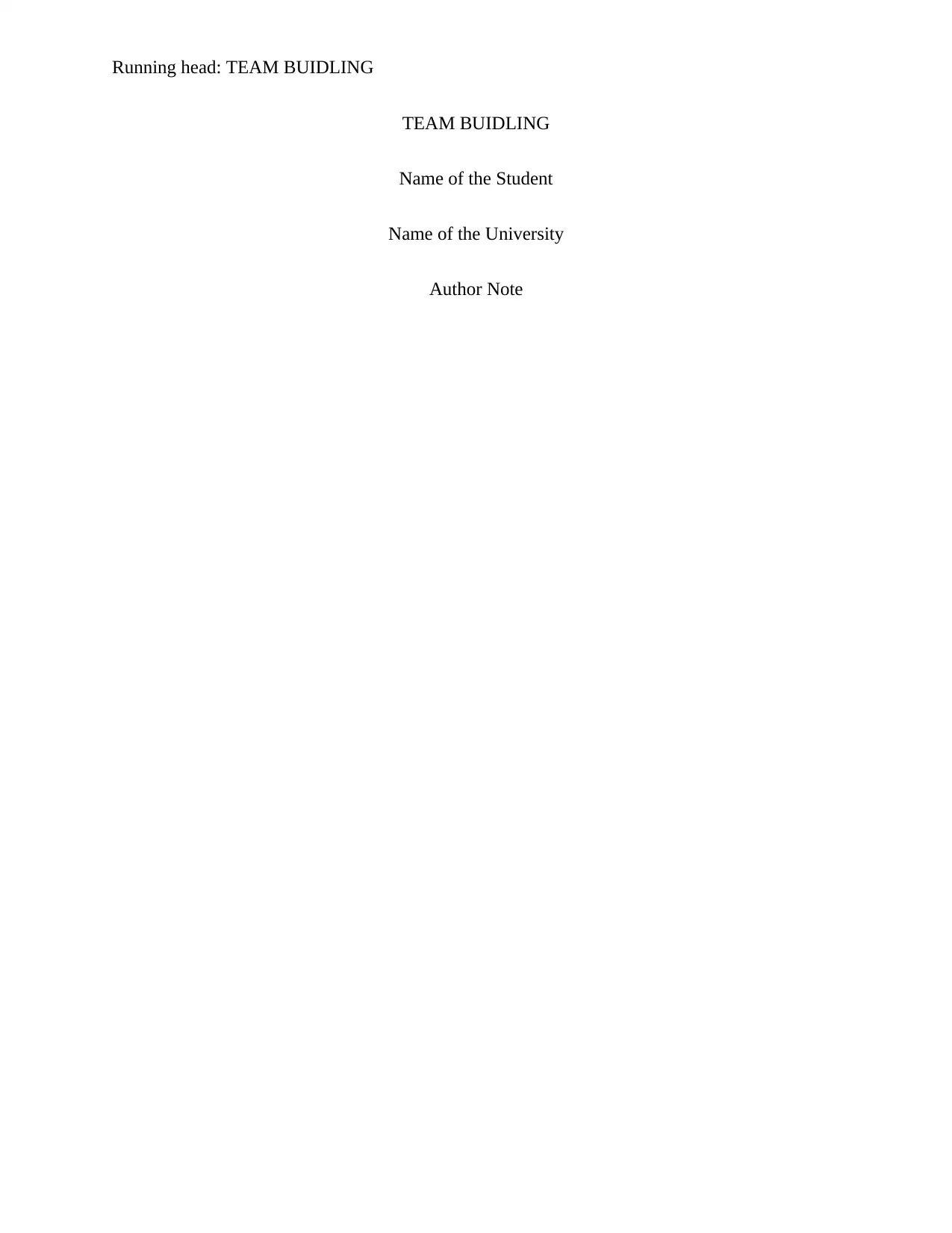
Running head: TEAM BUIDLING
TEAM BUIDLING
Name of the Student
Name of the University
Author Note
TEAM BUIDLING
Name of the Student
Name of the University
Author Note
Paraphrase This Document
Need a fresh take? Get an instant paraphrase of this document with our AI Paraphraser
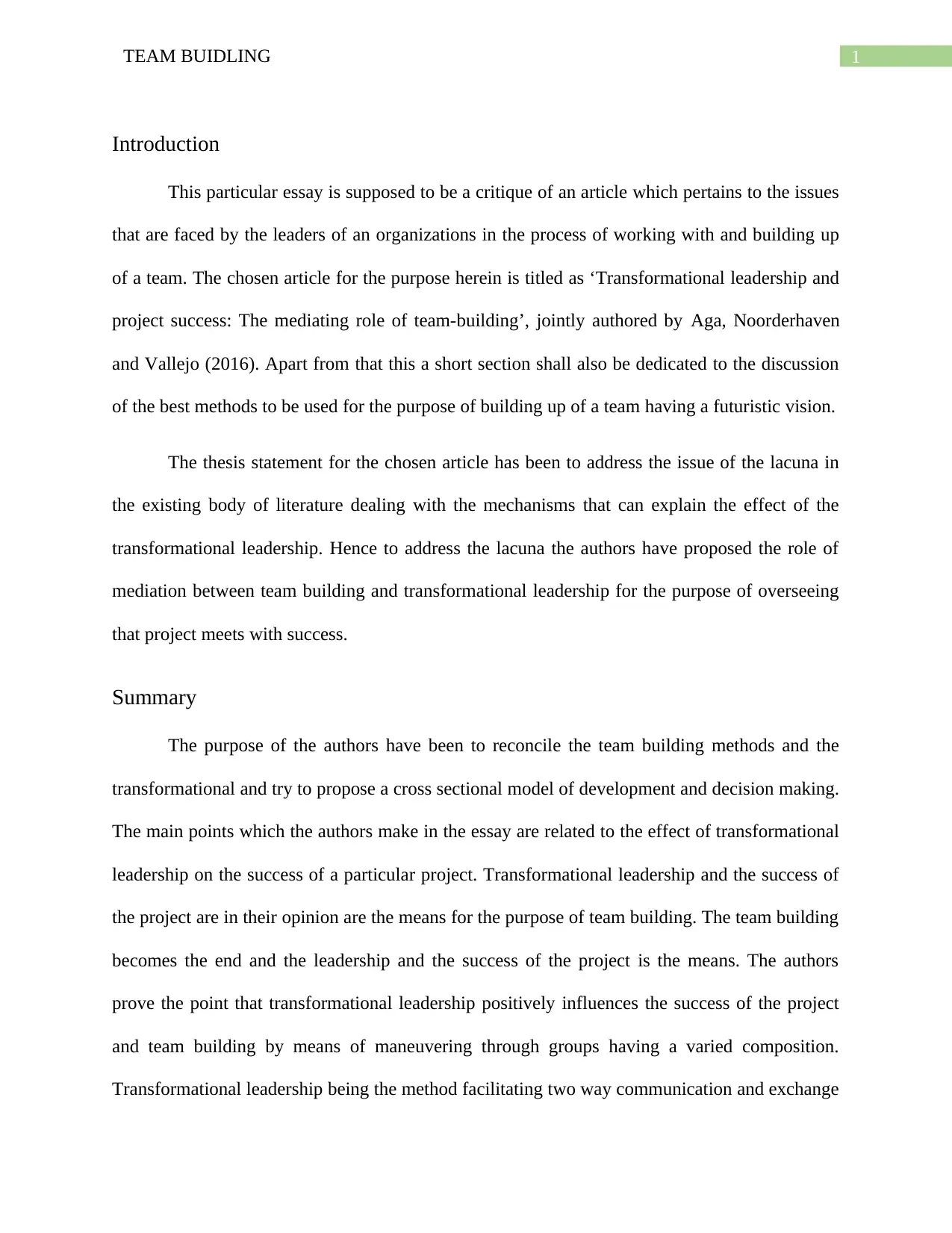
1TEAM BUIDLING
Introduction
This particular essay is supposed to be a critique of an article which pertains to the issues
that are faced by the leaders of an organizations in the process of working with and building up
of a team. The chosen article for the purpose herein is titled as ‘Transformational leadership and
project success: The mediating role of team-building’, jointly authored by Aga, Noorderhaven
and Vallejo (2016). Apart from that this a short section shall also be dedicated to the discussion
of the best methods to be used for the purpose of building up of a team having a futuristic vision.
The thesis statement for the chosen article has been to address the issue of the lacuna in
the existing body of literature dealing with the mechanisms that can explain the effect of the
transformational leadership. Hence to address the lacuna the authors have proposed the role of
mediation between team building and transformational leadership for the purpose of overseeing
that project meets with success.
Summary
The purpose of the authors have been to reconcile the team building methods and the
transformational and try to propose a cross sectional model of development and decision making.
The main points which the authors make in the essay are related to the effect of transformational
leadership on the success of a particular project. Transformational leadership and the success of
the project are in their opinion are the means for the purpose of team building. The team building
becomes the end and the leadership and the success of the project is the means. The authors
prove the point that transformational leadership positively influences the success of the project
and team building by means of maneuvering through groups having a varied composition.
Transformational leadership being the method facilitating two way communication and exchange
Introduction
This particular essay is supposed to be a critique of an article which pertains to the issues
that are faced by the leaders of an organizations in the process of working with and building up
of a team. The chosen article for the purpose herein is titled as ‘Transformational leadership and
project success: The mediating role of team-building’, jointly authored by Aga, Noorderhaven
and Vallejo (2016). Apart from that this a short section shall also be dedicated to the discussion
of the best methods to be used for the purpose of building up of a team having a futuristic vision.
The thesis statement for the chosen article has been to address the issue of the lacuna in
the existing body of literature dealing with the mechanisms that can explain the effect of the
transformational leadership. Hence to address the lacuna the authors have proposed the role of
mediation between team building and transformational leadership for the purpose of overseeing
that project meets with success.
Summary
The purpose of the authors have been to reconcile the team building methods and the
transformational and try to propose a cross sectional model of development and decision making.
The main points which the authors make in the essay are related to the effect of transformational
leadership on the success of a particular project. Transformational leadership and the success of
the project are in their opinion are the means for the purpose of team building. The team building
becomes the end and the leadership and the success of the project is the means. The authors
prove the point that transformational leadership positively influences the success of the project
and team building by means of maneuvering through groups having a varied composition.
Transformational leadership being the method facilitating two way communication and exchange
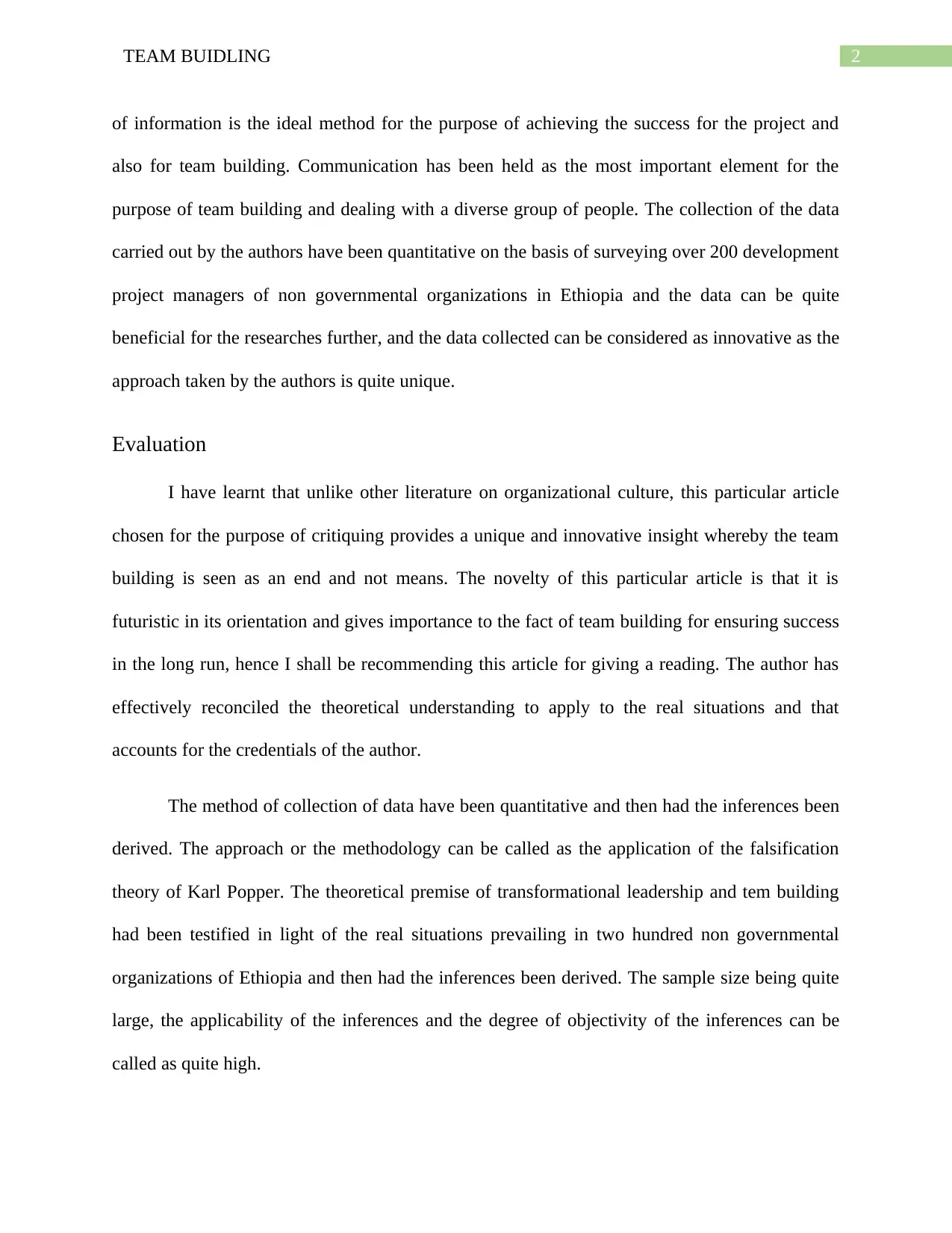
2TEAM BUIDLING
of information is the ideal method for the purpose of achieving the success for the project and
also for team building. Communication has been held as the most important element for the
purpose of team building and dealing with a diverse group of people. The collection of the data
carried out by the authors have been quantitative on the basis of surveying over 200 development
project managers of non governmental organizations in Ethiopia and the data can be quite
beneficial for the researches further, and the data collected can be considered as innovative as the
approach taken by the authors is quite unique.
Evaluation
I have learnt that unlike other literature on organizational culture, this particular article
chosen for the purpose of critiquing provides a unique and innovative insight whereby the team
building is seen as an end and not means. The novelty of this particular article is that it is
futuristic in its orientation and gives importance to the fact of team building for ensuring success
in the long run, hence I shall be recommending this article for giving a reading. The author has
effectively reconciled the theoretical understanding to apply to the real situations and that
accounts for the credentials of the author.
The method of collection of data have been quantitative and then had the inferences been
derived. The approach or the methodology can be called as the application of the falsification
theory of Karl Popper. The theoretical premise of transformational leadership and tem building
had been testified in light of the real situations prevailing in two hundred non governmental
organizations of Ethiopia and then had the inferences been derived. The sample size being quite
large, the applicability of the inferences and the degree of objectivity of the inferences can be
called as quite high.
of information is the ideal method for the purpose of achieving the success for the project and
also for team building. Communication has been held as the most important element for the
purpose of team building and dealing with a diverse group of people. The collection of the data
carried out by the authors have been quantitative on the basis of surveying over 200 development
project managers of non governmental organizations in Ethiopia and the data can be quite
beneficial for the researches further, and the data collected can be considered as innovative as the
approach taken by the authors is quite unique.
Evaluation
I have learnt that unlike other literature on organizational culture, this particular article
chosen for the purpose of critiquing provides a unique and innovative insight whereby the team
building is seen as an end and not means. The novelty of this particular article is that it is
futuristic in its orientation and gives importance to the fact of team building for ensuring success
in the long run, hence I shall be recommending this article for giving a reading. The author has
effectively reconciled the theoretical understanding to apply to the real situations and that
accounts for the credentials of the author.
The method of collection of data have been quantitative and then had the inferences been
derived. The approach or the methodology can be called as the application of the falsification
theory of Karl Popper. The theoretical premise of transformational leadership and tem building
had been testified in light of the real situations prevailing in two hundred non governmental
organizations of Ethiopia and then had the inferences been derived. The sample size being quite
large, the applicability of the inferences and the degree of objectivity of the inferences can be
called as quite high.
⊘ This is a preview!⊘
Do you want full access?
Subscribe today to unlock all pages.

Trusted by 1+ million students worldwide
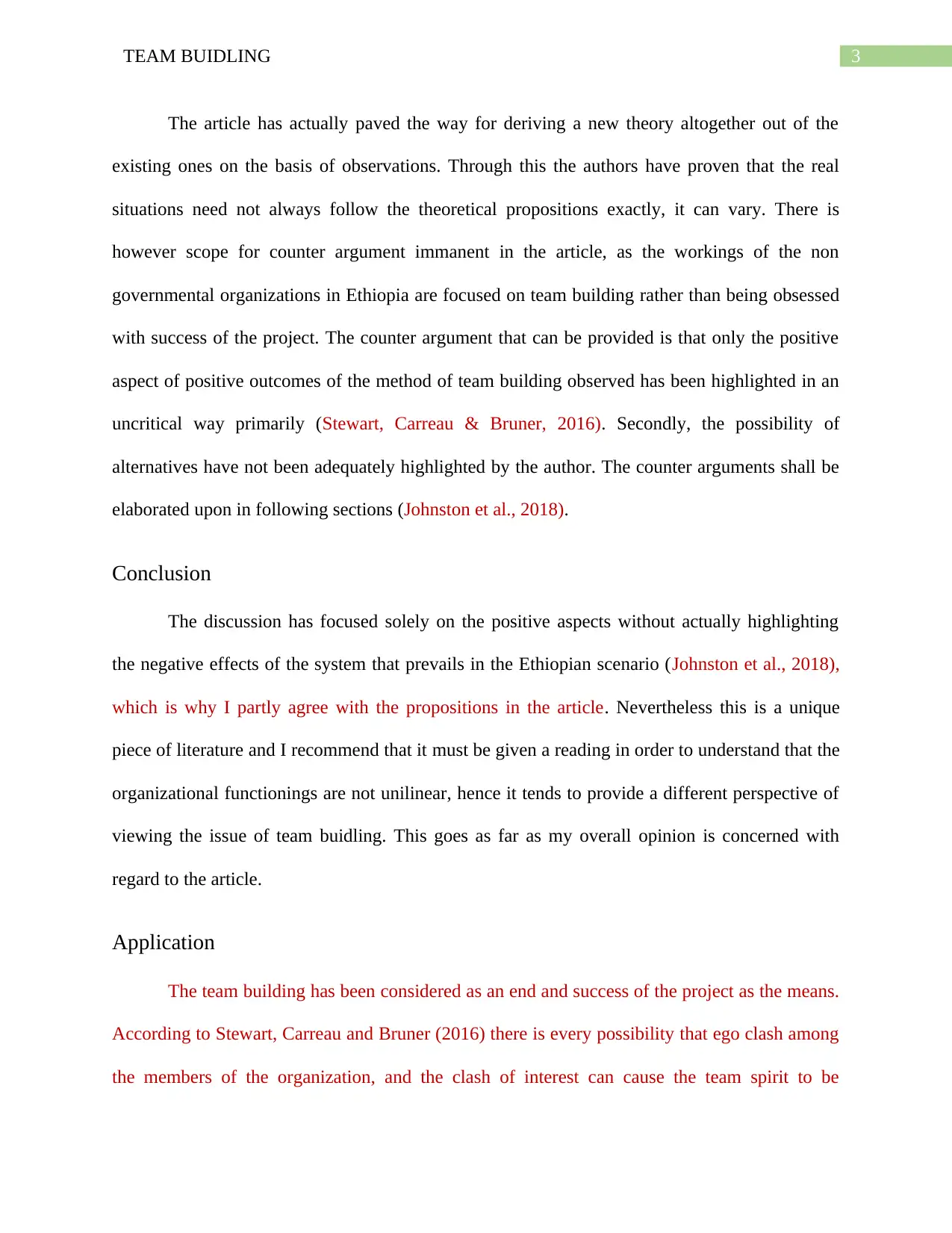
3TEAM BUIDLING
The article has actually paved the way for deriving a new theory altogether out of the
existing ones on the basis of observations. Through this the authors have proven that the real
situations need not always follow the theoretical propositions exactly, it can vary. There is
however scope for counter argument immanent in the article, as the workings of the non
governmental organizations in Ethiopia are focused on team building rather than being obsessed
with success of the project. The counter argument that can be provided is that only the positive
aspect of positive outcomes of the method of team building observed has been highlighted in an
uncritical way primarily (Stewart, Carreau & Bruner, 2016). Secondly, the possibility of
alternatives have not been adequately highlighted by the author. The counter arguments shall be
elaborated upon in following sections (Johnston et al., 2018).
Conclusion
The discussion has focused solely on the positive aspects without actually highlighting
the negative effects of the system that prevails in the Ethiopian scenario (Johnston et al., 2018),
which is why I partly agree with the propositions in the article. Nevertheless this is a unique
piece of literature and I recommend that it must be given a reading in order to understand that the
organizational functionings are not unilinear, hence it tends to provide a different perspective of
viewing the issue of team buidling. This goes as far as my overall opinion is concerned with
regard to the article.
Application
The team building has been considered as an end and success of the project as the means.
According to Stewart, Carreau and Bruner (2016) there is every possibility that ego clash among
the members of the organization, and the clash of interest can cause the team spirit to be
The article has actually paved the way for deriving a new theory altogether out of the
existing ones on the basis of observations. Through this the authors have proven that the real
situations need not always follow the theoretical propositions exactly, it can vary. There is
however scope for counter argument immanent in the article, as the workings of the non
governmental organizations in Ethiopia are focused on team building rather than being obsessed
with success of the project. The counter argument that can be provided is that only the positive
aspect of positive outcomes of the method of team building observed has been highlighted in an
uncritical way primarily (Stewart, Carreau & Bruner, 2016). Secondly, the possibility of
alternatives have not been adequately highlighted by the author. The counter arguments shall be
elaborated upon in following sections (Johnston et al., 2018).
Conclusion
The discussion has focused solely on the positive aspects without actually highlighting
the negative effects of the system that prevails in the Ethiopian scenario (Johnston et al., 2018),
which is why I partly agree with the propositions in the article. Nevertheless this is a unique
piece of literature and I recommend that it must be given a reading in order to understand that the
organizational functionings are not unilinear, hence it tends to provide a different perspective of
viewing the issue of team buidling. This goes as far as my overall opinion is concerned with
regard to the article.
Application
The team building has been considered as an end and success of the project as the means.
According to Stewart, Carreau and Bruner (2016) there is every possibility that ego clash among
the members of the organization, and the clash of interest can cause the team spirit to be
Paraphrase This Document
Need a fresh take? Get an instant paraphrase of this document with our AI Paraphraser
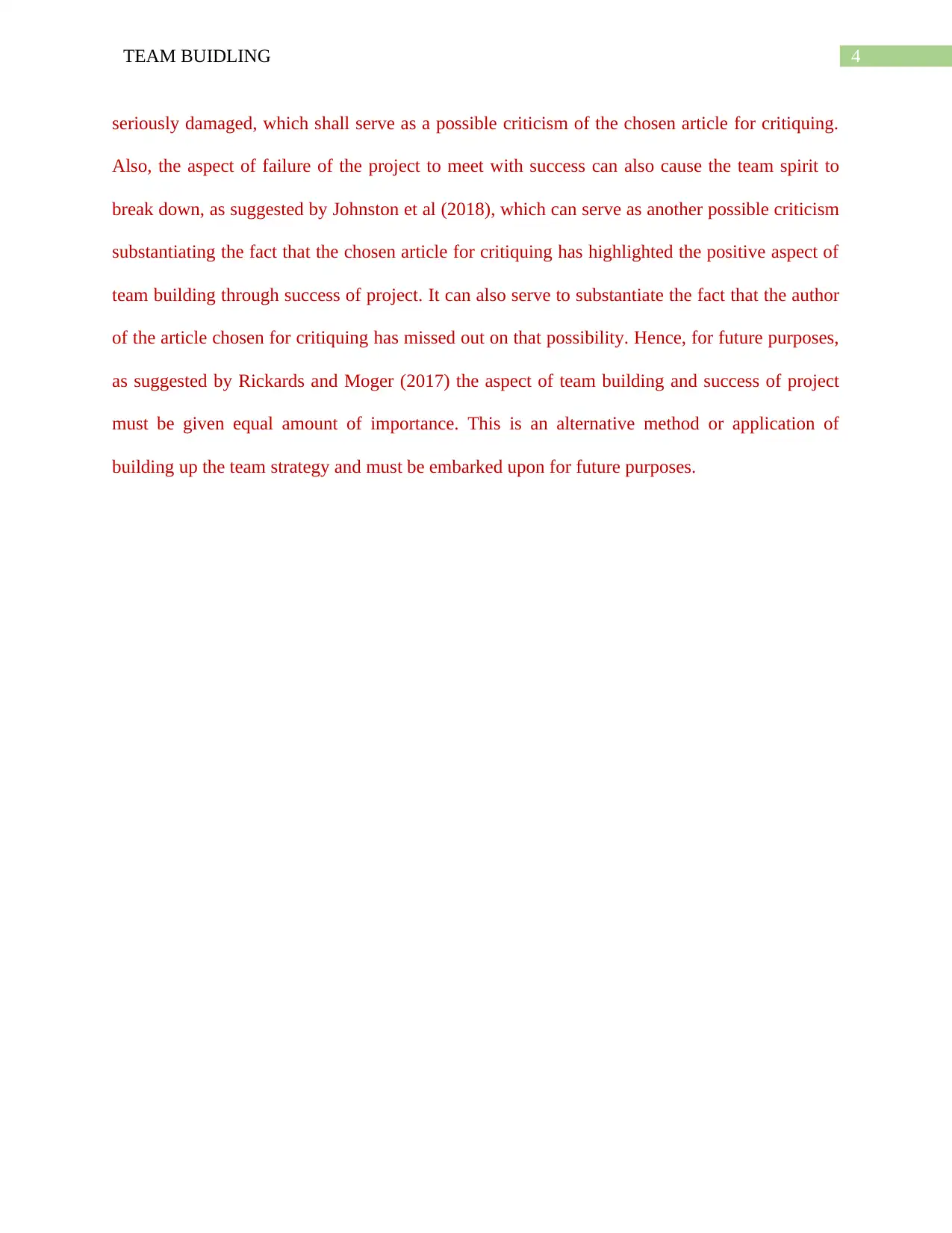
4TEAM BUIDLING
seriously damaged, which shall serve as a possible criticism of the chosen article for critiquing.
Also, the aspect of failure of the project to meet with success can also cause the team spirit to
break down, as suggested by Johnston et al (2018), which can serve as another possible criticism
substantiating the fact that the chosen article for critiquing has highlighted the positive aspect of
team building through success of project. It can also serve to substantiate the fact that the author
of the article chosen for critiquing has missed out on that possibility. Hence, for future purposes,
as suggested by Rickards and Moger (2017) the aspect of team building and success of project
must be given equal amount of importance. This is an alternative method or application of
building up the team strategy and must be embarked upon for future purposes.
seriously damaged, which shall serve as a possible criticism of the chosen article for critiquing.
Also, the aspect of failure of the project to meet with success can also cause the team spirit to
break down, as suggested by Johnston et al (2018), which can serve as another possible criticism
substantiating the fact that the chosen article for critiquing has highlighted the positive aspect of
team building through success of project. It can also serve to substantiate the fact that the author
of the article chosen for critiquing has missed out on that possibility. Hence, for future purposes,
as suggested by Rickards and Moger (2017) the aspect of team building and success of project
must be given equal amount of importance. This is an alternative method or application of
building up the team strategy and must be embarked upon for future purposes.
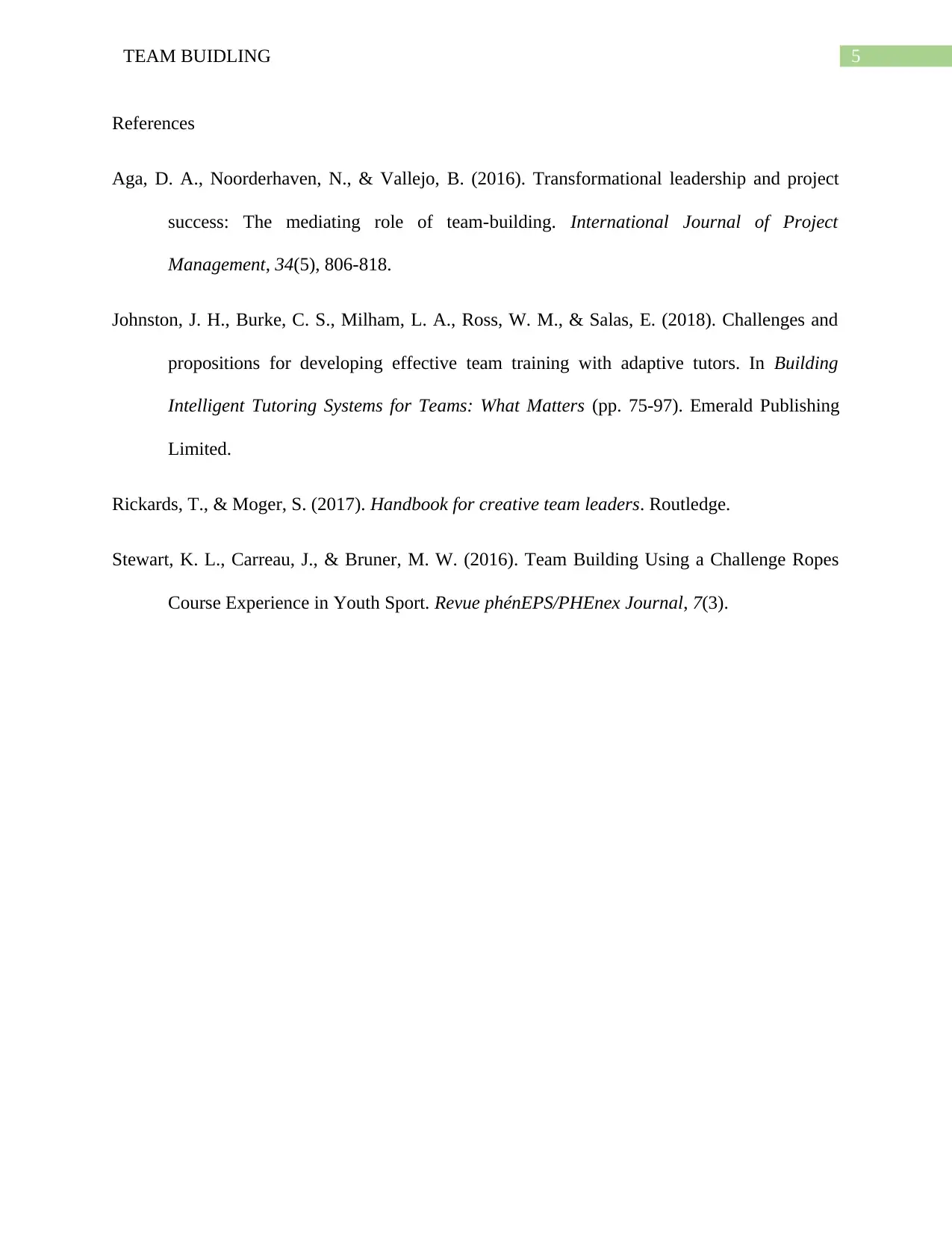
5TEAM BUIDLING
References
Aga, D. A., Noorderhaven, N., & Vallejo, B. (2016). Transformational leadership and project
success: The mediating role of team-building. International Journal of Project
Management, 34(5), 806-818.
Johnston, J. H., Burke, C. S., Milham, L. A., Ross, W. M., & Salas, E. (2018). Challenges and
propositions for developing effective team training with adaptive tutors. In Building
Intelligent Tutoring Systems for Teams: What Matters (pp. 75-97). Emerald Publishing
Limited.
Rickards, T., & Moger, S. (2017). Handbook for creative team leaders. Routledge.
Stewart, K. L., Carreau, J., & Bruner, M. W. (2016). Team Building Using a Challenge Ropes
Course Experience in Youth Sport. Revue phénEPS/PHEnex Journal, 7(3).
References
Aga, D. A., Noorderhaven, N., & Vallejo, B. (2016). Transformational leadership and project
success: The mediating role of team-building. International Journal of Project
Management, 34(5), 806-818.
Johnston, J. H., Burke, C. S., Milham, L. A., Ross, W. M., & Salas, E. (2018). Challenges and
propositions for developing effective team training with adaptive tutors. In Building
Intelligent Tutoring Systems for Teams: What Matters (pp. 75-97). Emerald Publishing
Limited.
Rickards, T., & Moger, S. (2017). Handbook for creative team leaders. Routledge.
Stewart, K. L., Carreau, J., & Bruner, M. W. (2016). Team Building Using a Challenge Ropes
Course Experience in Youth Sport. Revue phénEPS/PHEnex Journal, 7(3).
⊘ This is a preview!⊘
Do you want full access?
Subscribe today to unlock all pages.

Trusted by 1+ million students worldwide
1 out of 6
Related Documents
Your All-in-One AI-Powered Toolkit for Academic Success.
+13062052269
info@desklib.com
Available 24*7 on WhatsApp / Email
![[object Object]](/_next/static/media/star-bottom.7253800d.svg)
Unlock your academic potential
Copyright © 2020–2025 A2Z Services. All Rights Reserved. Developed and managed by ZUCOL.





